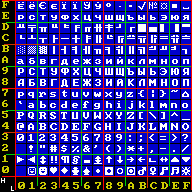
Back CP866 Czech Codepage 866 German CP866 Esperanto MS-DOS-koodisivu 866 Finnish CP866 Russian CP866 Ukrainian
 | |
| MIME / IANA | IBM866 |
|---|---|
| Alias(es) | cp866, 866[1] |
| Language(s) | Russian, Bulgarian; Partial support: Ukrainian,[a] Belarusian[b] |
| Standard | WHATWG Encoding Standard |
| Classification | OEM code page, extended ASCII |
| Extends | US-ASCII |
| Based on | Alternative code page |
| Other related encoding(s) | (See below) |
Code page 866 (CCSID 866)[2] (CP 866, "DOS Cyrillic Russian")[3] is a code page used under DOS and OS/2[4] in Russia to write Cyrillic script.[5][6] It is based on the "alternative code page" (Russian: Альтернативная кодировка) developed in 1984 in IHNA AS USSR and published in 1986 by a research group at the Academy of Science of the USSR.[7] The code page was widely used during the DOS era because it preserves all of the pseudographic symbols of code page 437 (unlike the "Main code page" or Code page 855) and maintains alphabetic order (although non-contiguously) of Cyrillic letters (unlike KOI8-R). Initially this encoding was only available in the Russian version of MS-DOS 4.01 (1990), but with MS-DOS 6.22 it became available in any language version.
The WHATWG Encoding Standard, which specifies the character encodings permitted in HTML5 which compliant browsers must support,[8] includes Code page 866.[9] It is the only single-byte encoding listed which is not named as an ISO 8859 part, Mac OS specific encoding, Microsoft Windows specific encoding (Windows-874 or Windows-125x) or KOI-8 variant.[9] Authors of new pages and the designers of new protocols are instructed to use UTF-8 instead.[10]
Two very similar but not identical encodings are standardised in GOST R 34.303-92[11] as KOI-8 N1 and KOI-8 N2 (not to be confused with the original KOI-8).
- ^ Character Sets, Internet Assigned Numbers Authority (IANA), 2018-12-12
- ^ "CCSID 866 information document". Archived from the original on 2016-03-27.
- ^ Cite error: The named reference
steelewas invoked but never defined (see the help page). - ^ Cite error: The named reference
OS2was invoked but never defined (see the help page). - ^ "Code page 866 information document". Archived from the original on 2016-03-16.
- ^ Cite error: The named reference
OEMwas invoked but never defined (see the help page). - ^ (in Russian) Брябрин В. М., Ландау И. Я., Неменман М. Е. О системе кодирования для персональных ЭВМ // Микропроцессорные средства и системы. — 1986. — № 4. — С. 61–64.
- ^ "8.2.2.3. Character encodings". HTML 5.1 2nd Edition. W3C.
User agents must support the encodings defined in the WHATWG Encoding standard, including, but not limited to […]
- ^ a b van Kesteren, Anne. "Legacy single-byte encodings". Encoding Standard. WHATWG.
- ^ van Kesteren, Anne. "Names and labels". Encoding Standard. WHATWG.
- ^ (in Russian) ГОСТ Р 34.303-92. Наборы 8-битных кодированных символов. 8-битный код обмена и обработки информации. = 8-bit coded character sets. 8-bit code for information interchange.
Cite error: There are <ref group=lower-alpha> tags or {{efn}} templates on this page, but the references will not show without a {{reflist|group=lower-alpha}} template or {{notelist}} template (see the help page).
© MMXXIII Rich X Search. We shall prevail. All rights reserved. Rich X Search